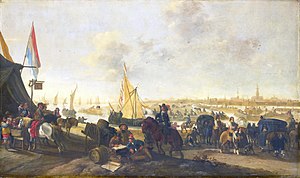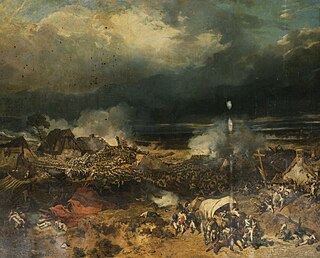
The Battle of Wattignies saw a French army commanded by Jean-Baptiste Jourdan attack a Coalition army directed by Prince Josias of Saxe-Coburg-Saalfeld. After two days of combat Jourdan's troops compelled the Habsburg covering force led by François Sébastien Charles Joseph de Croix, Count of Clerfayt to withdraw. The War of the First Coalition victory allowed the French to raise the siege of Maubeuge. At a time when failed generals were often executed or imprisoned, Jourdan had to endure interference from Lazare Carnot from the Committee of Public Safety. The village, renamed Wattignies-la-Victoire in honor of the important success, is located 9 kilometres (6 mi) southeast of Maubeuge.

The first siege of Zaragoza was a bloody struggle in the Peninsular War (1807–1814). A French army under General Lefebvre-Desnouettes and subsequently commanded by General Jean-Antoine Verdier besieged, repeatedly stormed, and was repulsed from the Spanish city of Zaragoza in the summer of 1808.
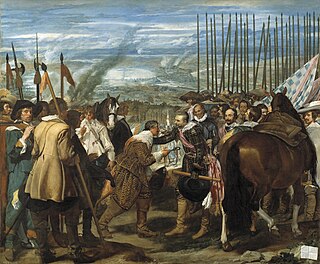
The siege of Breda of 1624–25 occurred during the Eighty Years' War. The siege resulted in Breda, a Dutch fortified city, falling into the control of the Army of Flanders.

The Battle of Kallo was a major field battle fought from 20 to 21 June 1638 in and around the forts of Kallo and Verrebroek, located on the left bank of the Scheldt river, near Antwerp, during the second phase of the Eighty Years' War. Following the symbolic recovery of Breda during the 1637 campaign, the Dutch Republic agreed with the French Crown, with whom it had allied in 1635, to besiege a major city in the Spanish Netherlands during the 1638 campaign. The commander of the Dutch States Army, Frederick Henry of Orange, planned an approach over Antwerp from the two sides of the Scheldt. Count William of Nassau-Siegen was entrusted to land in the Spanish-controlled Waasland region, west of Antwerp, to seize the forts of Kallo and Verrebroek, along with several other key fortifications, to invest Antwerp from the west. In the meantime, Frederick Henry would advance on the opposite bank to complete the blockade of the city while the armies of France invaded the Spanish Netherlands from the south to oblige the Spanish Army of Flanders to divide its forces.

The siege of Maastricht was fought between 9 June and 22 August 1632, when the Dutch commander Frederick Henry, Prince of Orange, eventually captured the city from Habsburg forces.
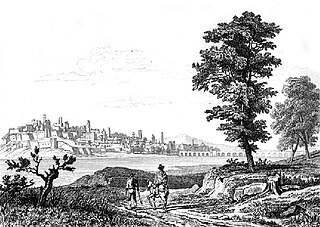
The Battle of the Gebora was a battle of the Peninsular War between Spanish and French armies. It took place on 19 February 1811, northwest of Badajoz, Spain, where an outnumbered French force routed and nearly destroyed the Spanish Army of Extremadura.

The Dano-Swedish War of 1658–1660 was a war between Denmark–Norway and Sweden, with the former backed by the Dutch Republic and Poland. It is known in Denmark as the Second Karl Gustav War, in Norway as Bjelkes Feud in Sweden as Karl Gustav's Second Danish War, and in the Netherlands as the Swedish-Dutch War.
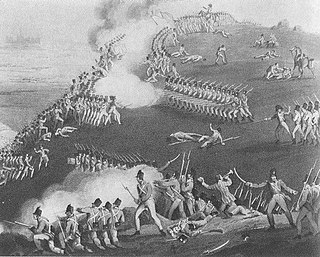
In the Battle of Castalla on 13 April 1813, an Anglo-Spanish-Sicilian force commanded by Lieutenant General Sir John Murray fought Marshal Louis Gabriel Suchet's French Army of Valencia and Aragon. Murray's troops successfully repelled a series of French attacks on their hilltop position, causing Suchet to retreat. The action took place during the Peninsular War, part of the Napoleonic Wars. Castalla is located 35 kilometers north-northwest of Alicante, Spain.

The Relief of Thionville took place on 7 June 1639, during the Thirty Years' War.

The siege of Leuven was an important siege in the Thirty Years' War in which a Franco-Dutch army under Frederick Henry of Orange and the French Marshals Urbain de Maillé-Brezé and Gaspard III de Coligny, who had invaded the Spanish Netherlands from two sides, laid siege to the city of Leuven, defended by a force of 4,000 comprising local citizen and student militias with Walloons, Germans, Spanish and Irish of the Army of Flanders under Anthonie Schetz, Baron of Grobbendonck. Poor organization and logistics and the spread of sickness among the French, along with the appearance of an Imperial-Spanish relief army of 11,000 under Cardinal-Infante Ferdinand and Ottavio Piccolomini, forced the invading army to lift the siege. This failure allowed the Spanish forces to take the initiative and soon the invaders were forced into a headlong retreat.
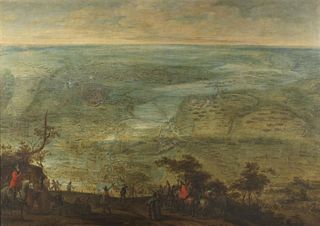
The siege of Saint-Omer was a siege in the Thirty Years' War in which a French army under Gaspard III de Coligny, Maréchal de Châtillon, laid siege to the Flemish city of Saint-Omer, defended by a small garrison in command of Lancelot II Schetz, count of Grobbendonck. Despite several initial successes in the capture of the minor forts around Saint-Omer, on the night of 8/9 June a Spanish relief army under Thomas Francis, Prince of Carignano surprised Châtillon's troops and established a small fort in the middle of the French lines. An entire army corps under Maréchal de La Force was ordered to move towards Saint-Omer to support Châtillon siege, but on 12 July a further Imperial-Spanish force commanded by Ottavio Piccolomini entered Saint-Omer, resolving the French marshals to withdraw.

The Battle of Mouscron was a series of clashes that occurred when the Republican French Army of the North under Jean-Charles Pichegru moved northeast to attack Menin and was opposed by Coalition forces under the overall leadership of François Sébastien Charles Joseph de Croix, Count of Clerfayt. In their initial advance, the French began the siege of Menin and captured Courtrai. With Habsburg Austrian reinforcements, Clerfayt counterattacked on the 28th but Joseph Souham soon massed superior French forces and drove the Coalition troops out of the area. This Flanders Campaign action happened during the War of the First Coalition, part of the French Revolutionary Wars. The battle occurred near Mouscron, Belgium, located at the French border 9 kilometres (6 mi) south of Kortrijk and at Menen, located 11 kilometres (7 mi) west of Kortrijk.
Louis François Félix Musnier de La Converserie became a general officer during the French Revolutionary Wars and led a division during the Napoleonic Wars. He joined the French Royal Army as an officer in 1781 after a spell in military school. Still a lieutenant in 1788, he enjoyed rapid promotion during the French Revolution. After serving as a general's aide, he was assigned to fight rebels in the Vendée. Later, he served as Adjutant General on two army staffs. In 1798 he was promoted to general of brigade for distinguished actions in Italy.

The Battle of the Lippe was a cavalry action fought on 2 September 1595 on the banks of the Lippe river, in Germany, between a corps of Spanish cavalry led by Juan de Córdoba and a corps of Dutch cavalry, supported by English troops, led by Philip of Nassau. The Dutch stadtholder Maurice of Nassau, taking advantage of the fact that the bulk of the Spanish army was busied in operations in France, besieged the town of Groenlo in Gelderland, but the elderly governor of the citadel of Antwerp, Cristóbal de Mondragón, organized a relief army and forced Maurice to lift the siege. Mondragón next moved to Wesel, positioning his troops on the southern bank of the Lippe river to cover Rheinberg from a Dutch attack. Maurice aimed then, relying on his superior army, to entice Mondragón into a pitched battle, planning to use an ambush to draw the Spanish army into a trap. However, the plan was discovered by the Spanish commander, who organized a counter-ambush.

The Battle of Wervik or of Wervik and Menin was fought on 12 and 13 September 1793 between 30,000 men of the French Army of the North commanded by Jean Nicolas Houchard, and 13,000 Coalition troops: the Veldleger of the Dutch States Army, commanded by the William, Hereditary Prince of Orange and his brother Prince Frederick of Orange-Nassau, and a few squadrons of Austrian cavalry under Pál Kray, seconded by Johann Peter Beaulieu. The great superiority in numbers being on the French side the battle ended in a victory for France, with the Dutch army suffering many losses. Among the casualties was Prince Frederick, who was wounded in the shoulder at Wervik, an injury from which he never fully recovered. The combat occurred during the Flanders Campaign of the War of the First Coalition. Menen is a city in Belgium located on the French border about 100 km (62 mi) west of Brussels.

Charles Louis Dieudonné Grandjean became a French division commander and saw extensive service during the Napoleonic Wars. In 1792 he gave up his legal career to enlist in the infantry and served in the Army of the Rhine. In March 1799 he earned promotion to general of brigade by distinguished actions at Verona. That year he led an Army of Italy brigade at Magnano, the Trebbia, Novi and Genola. In 1800 he fought at Stockach and Hohenlinden.
The Battle of Wismar took place on December 5, 1711 close to Wismar, Swedish Empire during the Great Northern War. A 3,000 strong Danish force under the command of Jørgen Rantzau blocked the Swedish city of Wismar. The Swedes under Martin von Schoultz, sent out 2,500 men from their garrison in an attempt to surprise the Danish forces camping a distance away. However, the Danish commander got words of the approaching Swedes and countered them, resulting in 478 Swedes dead, with another 1,500 captured to only 300 Danes killed and wounded.

The Battle of Arnhem saw Friedrich Wilhelm Freiherr von Bülow's Prussian corps fight an Imperial French division under Henri François Marie Charpentier at Arnhem. Attacking under the cover of fog, the Prussians broke into the city at several points and forced the French to retreat to Nijmegen after hard fighting in this War of the Sixth Coalition clash. Arnhem is a city in the Netherlands located on the Rhine River 100 kilometres (62 mi) southeast of Amsterdam.

The siege of Thionville was the siege of the town of Thionville during the Italian War of 1551–59. It was held by the Spanish against a French force under Francis, Duke of Guise and others. It lasted from 17 April to 23 June 1558 and resulted in a French victory.
